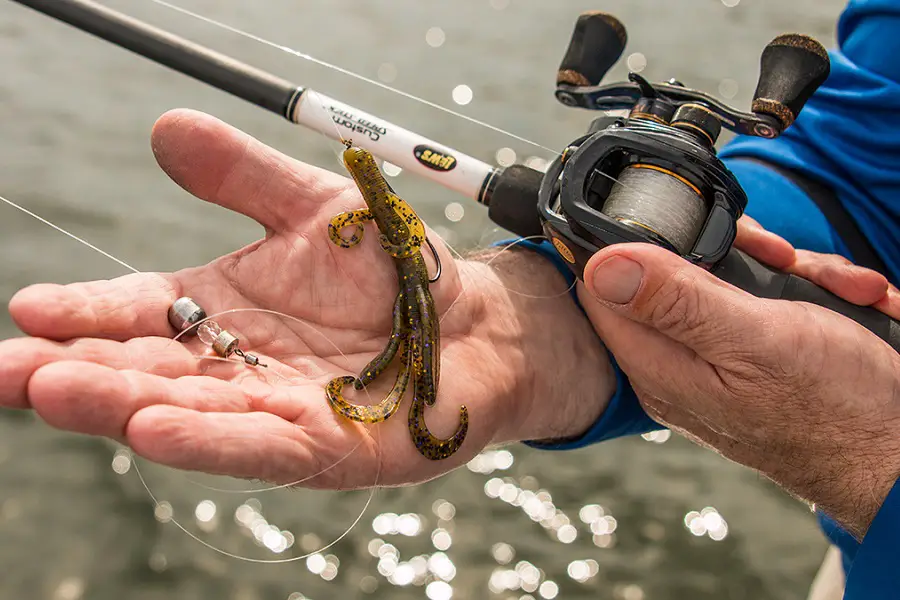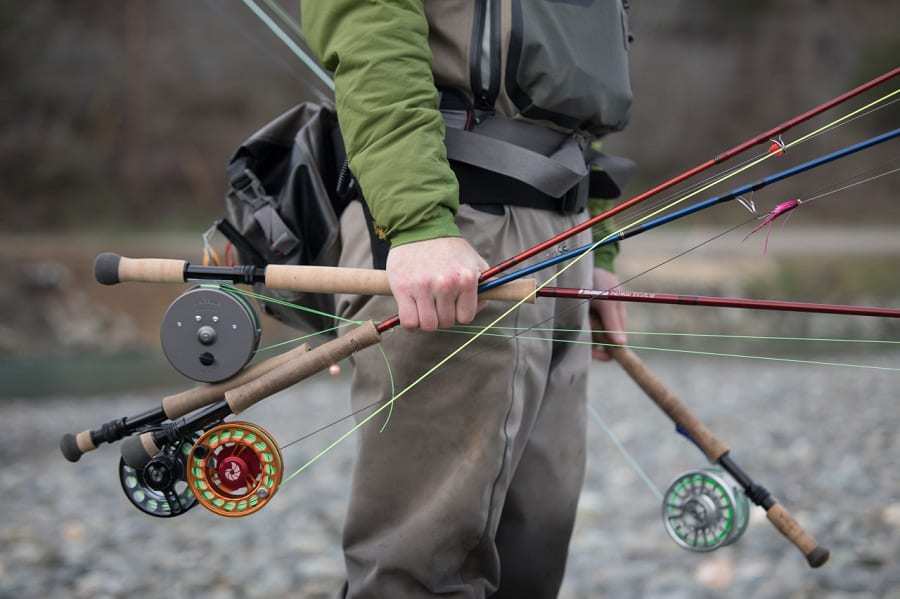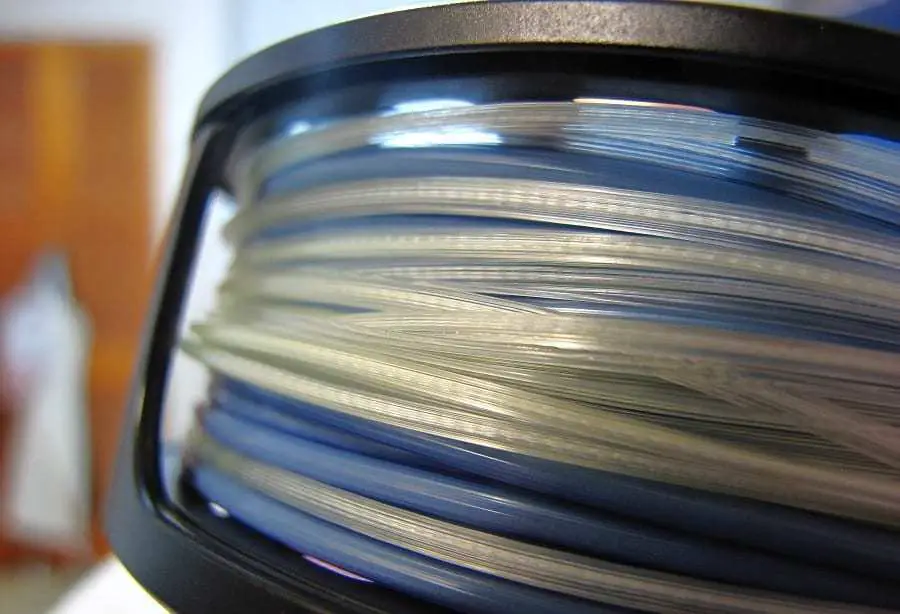If you find that you’re struggling to get anything to bite, and none of your usual strategies or tricks aren’t working, it may be time to try something new.
If you’re looking to catch some big bass, it might be worth trying out the Carolina rig.
This rig is pretty popular among bass anglers as it usually increases their chance of catching larger bass. If you haven’t tried the rig setup yet, you may be missing out on a better way to fish bass.
If you haven’t yet used it, you probably don’t know how it works, why it’s more appealing to bass and the best way to use it.
The rig may seem like a complicated setup, but it’s actually rather simple to set up once you know how. Understanding how the Carolina rig works may improve your ability when it comes to catching bass, as larger bass find themselves more naturally drawn to the lure.
Finding out why you should use the rig is just as simple as setting it up.
Let’s get started on everything you need to know about the Carolina rig…
How to Setup a Carolina Rig
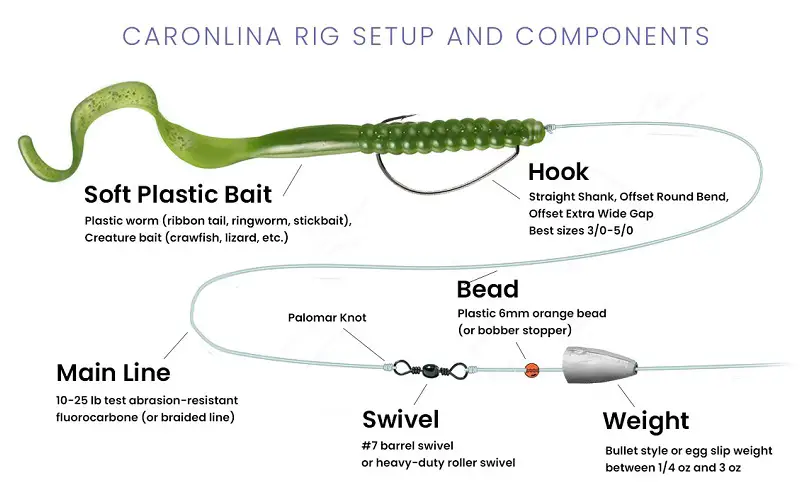
Understanding how to set up a Carolina rig is pretty easy. To begin, you will need:
- Fishing rod: You ideally want a 7 ft 6” or longer, medium-heavy rod.
- Beads: You can use either glass or plastic beads, but most anglers prefer to use plastic beads. The beads protect the knot from the weight as it slides up and down.
- Hooks: Use hooks based on your bait or lure.
- Swivel: Use a swivel based on your tackle size. Alternatively, you can use a Carolina Keeper instead, which will require less knot tying and will easily allow you to adjust the lead length.
- Leader Line: For line you can use a braided line, monofilament line, or fluorocarbon line. Most anglers prefer to use fluorocarbon.
- Singers/Weights: Here you can use barrel sinkers or bullet head sinkers. Lead sinkers are pretty common, but you should definitely consider paying extra for tungsten weights.
- Reel: For a Carolina rig, it’s best to use a baitcasting reel, preferably one with 6:1 gear ratio so that you can bring your line in quickly when you need to.
Now you have all the equipment you’ll need, it’s time to move on to how you actually set up the rig.
To make a Carolina rig, you need to put a slip sinker and bead on the line before you add your swivel and leader. Once your swivel is attached, you’ve created a Carolina rig.
Of course, you’ll have to continue setting up your lead, hooks and lures.
You can choose any kind of leader length that suits you, but most people tend to opt for 3-foot leaders. If you’re fishing in shallow waters, a shorter leader length will work fine.
However, if you’re fishing in deeper waters, a 3-foot leader length is still recommended.
It’s also completely up to you which lure you choose to use too. The two most popular options are soft-bodied crawfish or soft bodied worm – whichever hook you use will depend on the lure you’ve chosen. Some people believe that the best Carolina rig worms are soft plastic lures rather than live bait.
Just keep in mind that there is no one-size fits all Carolina rig hook. So, you should have different hooks on hand in case you decide to swap out your lures.
One of the most important parts of a Carolina rig is the rotating swivel. If the swivel snags, it can keep the bait from spinning as it should. However, it can be difficult tying a spinning swivel ring, so we recommend using a Palomar knot to hold everything together.
Some anglers use standard lead sinkers and others prefer to use tungsten weights. You can use whichever you please, but we recommend spending a little extra and purchasing tungsten weights.
One of the biggest advantages of using a Carolina rig is that you can adapt the rig based on the equipment you have available.
For the most basic setup, use a sliding bead along with a sliding sinker so both can slide into the swivel. Using a neoprene stop attached to the swivel will also help to eliminate any line damage.
The reason as to why the Carolina rig is so popular is that it can be set up in under two minutes. Anglers looking to catch fish don’t have time to waste tying lots of knots or lengthy setups – the Carolina rig is both fast and simple.
Why do Carolina Rigs Work so Well?
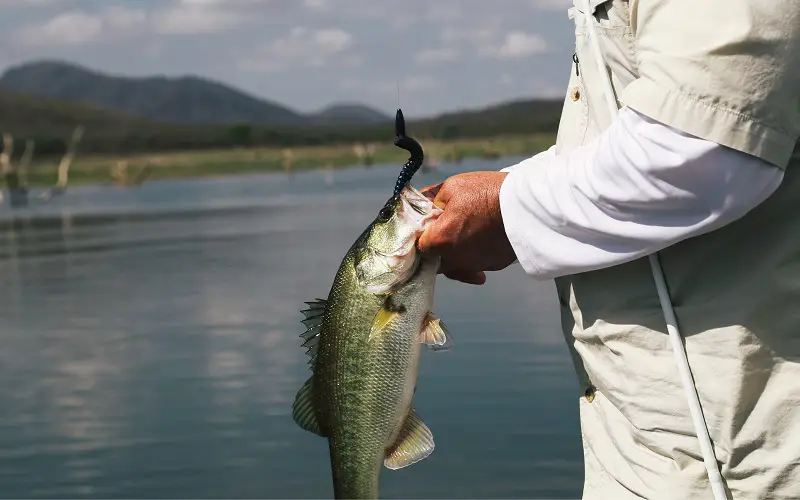
Bass fish have two different feeding patterns – opportunistic and aggressive. When they are in their aggressive feeding mode, bass fish will attack anything that looks like food. This is where the Carolina rig works well, but it also really shines during the lazy feeding mode.
During this feeding mode, bass tend to stay in one spot, and begin to lazily look around for food when they’re hungry.
Using a Carolina lure, you can drop bait right in front of the fish and it will decide whether it wants to bite or not.
If the fish doesn’t initially go for the bait, the circular motion will bring the bait back around until the fish decides it wants to go for it.
The sliding sinker is important as it keeps the rig low in the water, which will make the bass far more likely to bite. In general, professional bass anglers will use the Carolina rig to find where the fish are before they switch to another rig – but this might not be the smartest move.
When Should I Use a Carolina Rig?
The Carolina rig is a very versatile tool, and will perform best under certain circumstances. The rig is pretty effective in spring, but it’s most useful during the winter months.
During the colder season, bass tend to stick to the bottom of deeper waters, as the water near the surface is far too cold.
So, during the winter, you need a rig that will sink to the bottom of a body of water with ease. As the Carolina rig has a heavy weight, anglers can cast further into the water’s depths.
This will increase your chances of catching bass.
It’s also worth noting that on windy and cloudy days, bass will tend to swim around more than they would on warmer, sunnier days.
This is the opportune chance to use the Carolina rig as you’ll need a lure that will cover a larger surface area. The heavy sinker will also put the rig at the bottom of water in the path of the bass.
How Do You Use a Carolina Rig?

As mentioned earlier, a Carolina rig works best with a stiff fishing rod that is over 7 feet. It is also recommended that you use a baitcasting reel that has a high speed as it will be able to quickly take the slack out of the line and set the hook as soon as the bass bites.
Hold your rod so that it is parallel to the water, making sure it’s in the direction that you want to cast your rig. Imagine the rig is sitting at a 12 o’clock position.
You’ll want to move your rod back and forth from 12 o’clock to 2 o’clock, being sure not to move too quickly – the key is to be as slow as possible.
Repeating this motion will make the bait spin in a circular motion, and the bait will dance at the bottom. This should attract the fish to the lure for a bite.
How is the Carolina Rig Unique?
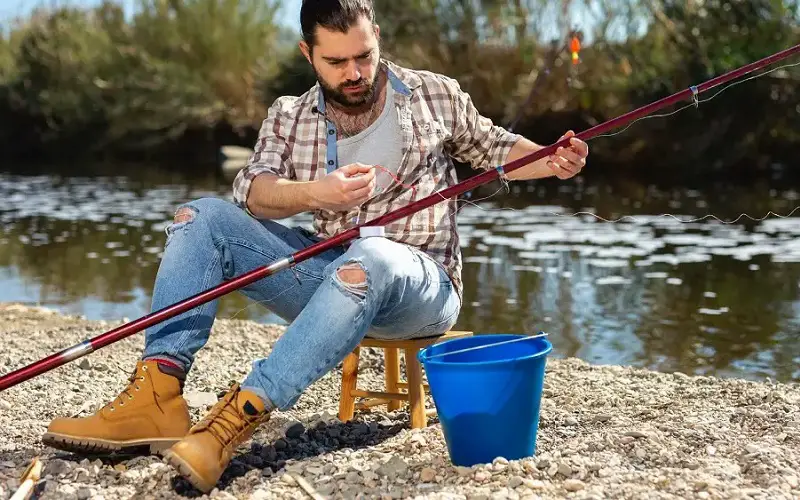
The Carolina rig is pretty similar to the Texas rig, as both use a bead and a sliding sinker. However, the biggest difference is that the Texas rig doesn’t use a swivel and a leader. So, this means the hook itself will actually sink to the bottom.
Because of this, hook placement is far more important in Texas rigs than in Carolina rigs. The lure on a Texas rig will “swim” through the water rather than spin. As there is no circular motion, the Texas rig doesn’t cover as much area as the Carolina rig.
If we also compare the Carolina rig to a drop shot rig, you will see that the drop shot rig uses a Palomar knot to attach a drop shot hook onto the main line. A weight is then attached to the end of the line about 10-12 inches below.
This setup will either anchor the hook in one spot, or drag it across the bottom. The biggest difference between these two rigs is the motion of the lure as you move the rod around.
The drop shot rig will twitch the bait right in front of a fish, trying to lure it in. On the other hand, the Carolina rig will dance around a larger area of the water, trying to attract multiple fish at once.
When Not to Use the Carolina Rig?
As mentioned previously, the Carolina rig is a pretty versatile rig, however, there are some situations when you should choose a different rig to use. Some of these restrictions include:
- Thick Vegetation: A Carolina rig will snag and tangle due to the long leader.
- Dense Brush Coverage: Similarly, the Carolina rig will snag where there is dense brush coverage.
- Rocky Bottom: If there are a lot of rocks or boulders at the bottom of the water, there might be some problems if the rig snags while it rotates or drags.
Apart from these scenarios, the Caroline rig is a pretty adaptable setup which can be used virtually anywhere.
Options to Make the Rig Better
As mentioned earlier, you should definitely consider spending extra on tungsten weights rather than lead weights. Tungsten weights are smaller, hard and denser, which will make more noise on the line.
Changing your leader line can also make such a difference. Most professional anglers prefer to use a fluorocarbon line as it has the sensitivity you need to detect a fish.
However, other anglers recommend braided or mono lines. Whichever you choose, it’s important that the leader is undetectable underwater.
When it comes to picking a lure, don’t assume that you should use soft Carolina rig worms. Although soft bodied worm lures work great, you also need some other options too.
You can also use soft-bodied lures that mimic crawfish. Whatever you choose, make sure you keep the color range wide.
As we also mentioned earlier, it’s also better to use glass beads instead of plastic beads. Although plastic beads are cheaper, glass beads make more noise when they come into contact with the sinker/weights.
By using these tips to maximise your rig, you increase your chances of catching more bass.
Using the Carolina Rig for Other Fish
Although the Carolina rig is most effective for bass, it’s also pretty useful for catching any other bottom-feeding species – all you need to do is change the bait. A lot of anglers also use a Carolina rig to catch catfish or flounder.
When catching catfish, the rig is known as a slip sinker rig, and a far bigger tackle is used compared to bass tackle. For bass fishing, a 12-15 lb leader is typically used. For catfish, you will need a 40-50 lb leader.
Similarly, when using the rig for flounder, you should use a heavier leader.
Now that you know all you need to know about the Carolina rig, we hope you’re prepared to take your bass fishing to the next level!
References:


